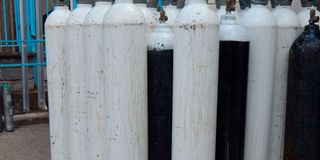The status of Kenya's medical oxygen infrastructure

Oxygen cylinders at the Ministry of Health warehouse.
What you need to know:
- Our big take-away from Covid-19 pandemic is the urgent need to scale up our medical oxygen supply system.
- Oxygen availability in Kenya varies depending on the location and the type of facility.
Can Kenya and Africa manufacture and sustain her own medical oxygen? What will this take?
Our big take-away from Covid-19 pandemic is the urgent need to scale up our medical oxygen supply systems and at PATH we have been working with Kenya and other governments in the region to identify market-based solutions to ensure high-quality oxygen is readily available and properly used with pulse oximetry (a test used to measure the oxygen level (oxygen saturation) of the blood) where it is most needed.
The objective is to gain insights that will enable low- and middle-income countries to improve access to oxygen and pulse oximetry in their public health systems.

More than 30 per cent of emergency facilities in Kenya do not have any oxygen while 90 per cent don’t have piped oxygen, according to a new report by the Access to Medicine Foundation. How should the government deal with this situation because all it has been doing is distributing oxygen cylinders across the 47 counties?
Oxygen availability in Kenya varies depending on the location and the type of facility. We recently visited Kenyatta National Hospital (KNH) and were impressed by what we saw, there is a lot of progress being made and we are happy to partner with the government.
The cylinders that President Ruto has been distributing are important and will go a long way in saving lives.
In 2020, a report published by Kenya’s Health Ministry recommended the need to scale-up medical oxygen availability in public primary hospitals as oxygen availability was higher in privately owned facilities and secondary hospitals. But nothing has happened. How do we get African governments such as Kenya’s to listen because much as they throng to events like WHA and make good speeches, nothing ever changes.
Remember that although there are many oxygen and pulse oximeter suppliers selling products in the global market, their use is not widespread in public health facilities and most oxygen in the Kenyan public health system is delivered using cylinders.
This is why we are working with the Kenyan government to help them build more capacity. Multiple oxygen generation plants have been installed in the last three years and at least seven more are currently under construction and this is due in part to the success of two unique programmes: an oxygen plant operating as a public-private partnership in Siaya County and a medical equipment leasing programme. Both were launched in 2015 and are receiving attention as examples of models that could be scaled further in Kenya and emulated in other countries.
As you may know, many medical facilities in low and low middle income countries do not have reliable access to medical oxygen, which is a lifesaving treatment for a wide array of diseases such as pneumonia and tuberculosis. It is also essential for daily medical procedures, for example during surgery and childbirth. And so how are we going to attain Universal Health Coverage (UHC) at this rate?
It is exciting that the 76th World Health Assembly has recognised the inclusion of medical oxygen as a life-saving essential medicine with no substitute on the 22nd World Health Organization Model List of Essential Medicines and the 8th World Health Organization Model List of Essential Medicines for Children, where it is an indication for the management of hypoxaemia including for vulnerable groups, and anesthesia that is essential for surgery and trauma , this is very good news and will go a long way in helping low-income countries attain UHC.
Do you think African health systems have a management problem? Should we have politicians running health dockets and might having doctors and health experts at the helm influence policy changes and fix our medical oxygen problems?
Everyone, including politicians, has an important role to play towards building and attaining proper functioning health systems that will benefit all and sundry. Previously, British Oxygen Company was the only oxygen cylinder provider, but the number of private-sector cylinder suppliers has grown in recent years. There is also significant interest to increase the number of government-owned oxygen plants.
Where do we go from here?
To be honest Kenya is making progress to increase access to oxygen by using novel methods to procure and operate oxygen generation plants though it is important to consider the country’s total needs and the most appropriate mix to meet the needs.
As PATH we have learnt and acknowledged that because health care decision-making and management lies with county health management teams in each of the 47 counties. Planning for a large-scale oxygen infrastructure programme can be challenging. If the counties in Kenya continue to scale oxygen infrastructure, it is recommended that they work together to ensure they right-size oxygen delivery solutions. For example, if each county
builds a large-scale oxygen generation and cylinder filling system, they may struggle to utilise the installed production capacity and take full advantage of their capital investment unless they can distribute cylinders to facilities across surrounding counties.





